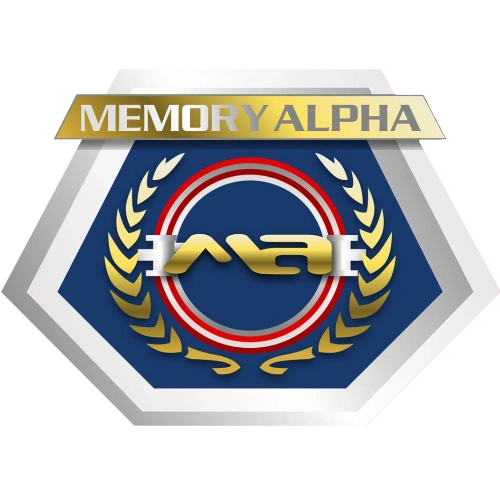|
Ten artykuł jest właśnie poddawany intensywnej rozbudowie. Poniżej znajduje się treść medalowego artykułu Anglojęzycznej Wersji Memory Alpha. Jeśli chcesz wspierać rozwój Polskiej Wersji Memory Alpha pomóż przetłumaczyć go na język polski! Zobacz też inne tłumaczone strony oraz Pomoc dla tłumaczy. |
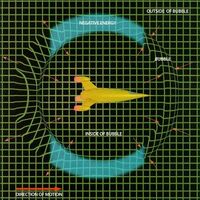
Fizyka Warp

USS Enterprise (alternatywna rzeczywostość) z alternatywnej rzeczywistości w warp.
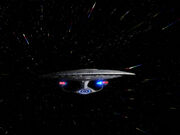
USS Enterprise-D w warp
| “ | AHHHHHHHHHHHH!!!! | ” |
| —Zefram Cochrane osiągając Warp 1 | ||
Napęd warp jest technologią pozwalającą na podróże kosmiczne z prędkościami nadświetlnymi. Działa on poprzez generowanie pola warp w formie bąbla podprzestrzennego, które otacza statek, uginając lokalnie przestrzeń i prowadząc statek z prędkością dużo przekraczającą prędkość światła. Prędkości te są określane według współczynnika warp. Napęd warp jest najpopularniejszym sposobem transportu międzygwiezdnego w galaktyce Drogi Mlecznej, czyniąc możliwymi miedzygwiezdną eksplorację, handel oraz wojny.
Etymologia
W 2063 terminu "napęd warp" użył już Zefram Cochrane, odnosząc go do swojego silnika w Phoeniksie. Aczkolwiek Cochrane na wyświetlaczach swojego statku używał określenia "generator przestrzeni warp" (Star Trek: Pierwszy Kontakt). Nawet jeszcze w 2150s, silnik warp pięć oficjalnie nazywany był "odkształcać pola grawimetrycznego" (ENT: „Cold Front”).
Większość kultur w Drodze Mlecznej używa określenia "napęd warp", a od późnego 23-ego stulecia jest to najpopularniejszy termin również w Federacji (Star Trek: The Original Series, et al.). W latach 2250- w Gwiezdnej Flocie używano terminu "hipernapęd" (TOS: „The Cage”) a Ferengi używali czasami określenia "napęd świetlny" (TNG: „Peak Performance”).
Technologia
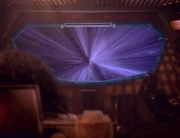
Rotarran przyspiesza do warp, widok z wnętrza statku.
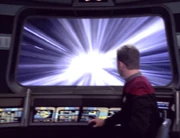
The USS Voyager przyspiesza warp
Federacyjne silniki warp z 24 wieku napędzane były reakcją materii (deuteru) i antymaterii (antydeuteru), za pośrednictwem kryształów dylitu, który nie reaguje z antymaterią w obecności pola elektromagnetycznego o wysokiej częstotliwości. Reakcja wytwarza wysoko energetyczną plazmę, zwaną elektro-plazmą lub plazmą warp, która jest odprowadzana przewodami plazmowymi systemem elektro-plazmowym (EPS). Następnie elektro-plazma wstrzykiwana jest iniektorami do cewek pola warp, ulokowanych z reguły na osobnych gondolach. Cewki te zbudowane są z verterium cortenide i generują pole warp. Plazma jest w odpowiednich momentach wstrzykiwana w przestrzeń między cewkami co daje efekt "nawarstwiania" się pola podprzestrzennego, popychając statek naprzód.
Inne cywilizacje używają innych źródeł energii, jak na przykład Romulanie, którzy do zasilania swoich napędów warp posługują się sztuczna osobliwością kwantową, ale podstawowy proces jest podobny. Na niektórych statkach, jak w przypadku klasy Intrepid, gondole montowane są na pylonach o zmiennej geometrii.
Części układu
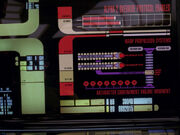
Główne komponenty napędu warp

- Antimatter containment
- Antimatter inducer
- Antimatter relay
- Deuterium cartridges
- Electro-plasma
- Emergency shutdown trips
- Main stage flux chiller
- Magnetic interlock
- Gondole
- Kolektory Bussarda
- Iniektory plazmowe
- Cewki warp
- Nullifier core
- Pre stage flux chiller
- Phase inducer
- Plasma conduit
- Plasma intercooler
- Plasma coolant
- Plasma regulator
- Power transfer conduit
- Power transfer grid
- Space matrix restoration coil
- Warp field generator
- Warp plasma conduit
- Warp core / matter/antimatter reaction assembly
- Antimatter injector
- Antiproton injection seal
- Dilithium crystal chamber
- dilithium articulation frame
- dilithium chamber hatch
- dilithium crystal
- dilithium regulator
- Intermix chamber
- Matter injector/deuterium injector
- Theta-matrix compositor
Rodzaje
- Class 7 warp drive
- Class 9 warp drive
- Enhanced warp drive
- S-2 graf unit
- Subspace resonator
- Tetryon plasma warp drive
- Tricyclic plasma drive
- Warp five engine
- Warp three engine
- Yoyodyne pulse fusion
Rozwój
Warp drive and other faster-than-light (FTL) propulsion technologies were the linchpin of an interstellar civilization, making trade and exploration across vast interstellar distances viable. Without these technologies, these distances could not be crossed in any reasonable period of time, making interstellar civilization usually limited to a single sector. (TNG: „A Matter of Time”) To put this in perspective, planets that were years away with impulse speeds could be reached in days with ships equipped with warp drive. (TOS: „Where No Man Has Gone Before”)
Cultures in the galaxy discovered warp drive at their own pace and rate of development, as most of the cultures had to do. The Vulcans were an interstellar civilization by 9th century BC. (ENT: „The Andorian Incident”) They invented warp drive some time after 1947 and had reached the level of warp 7 by 2151. (ENT: „Fallen Hero”; DS9: „Little Green Men”) Klingons had interstellar travel capability around the time of Kahless in the 9th century. They also invented warp drive some time after 1947 and had achieved the capability of warp 6 by 2151. (TNG: „Rightful Heir”; DS9: „Little Green Men”; VOY: „Day of Honor”; ENT: „Judgment”) Romulans were once considered a group of thugs and warp drive was regarded as the key technology that allowed the founding of their Star Empire. (Star Trek: Rebelia) The Vissians developed warp drive around the 12th century. (ENT: „Cogenitor”) The Borg in the Delta Quadrant began to establish their interstellar collective by the 15th century. (VOY: „Dragon's Teeth”) However, it was the rapid progress of Humanity which led to the wide-scale exploration of the galaxy and the formation of the United Federation of Planets.
The development of the warp drive was recognized by the United Federation of Planets as the marker of an advanced society. It was only after a people developed warp drive that the Federation made contact, as codified in the Prime Directive. (TNG: „First Contact”)
21 wiek

Phoenix goes to warp
On Earth, warp drive was initially developed by Zefram Cochrane, in the period following World War III. (Star Trek: Pierwszy Kontakt)
The spacecraft credited with discovering the space warp phenomenon was the Bonaventure (C1-21). (DS9: „The Nagus”, production art)
Despite the hardships imposed by the war's aftermath and the lack of advanced materials, Cochrane was able to build a manned warp-capable vessel using a converted Titan II missile. The successful first flight of his ship – the Phoenix – took place on April 5, 2063, and drew the attention of a Vulcan exploratory vessel, leading to the event known as First Contact. (Star Trek: Pierwszy Kontakt)
The Bonaventure (10281NCC) then became the first deep-space starship to have warp drive installed. (TAS: „The Time Trap”)
22 wiek
Development of warp technology proceeded slowly over the next eighty years, after the flight of the Phoenix – due, in no small part, to the cautious advice of the Vulcans – and it was not until the 2140s that a warp engine developed by Henry Archer at the Warp Five Complex could exceed warp factor 2.
This engine was successfully tested in the second NX prototype by Commanders A.G. Robinson and Jonathan Archer to a speed of warp 2.5, breaking the so-called "warp 2 barrier." (ENT: „First Flight”)
By the year 2151, warp technology was sufficiently advanced to allow a vessel to travel at warp 5, and the first Human starship, Enterprise, was built with this capability. (ENT: „Broken Bow”) Although Enterprise was at first unable to fully realize this potential (maxing out at warp 4.7), the starship finally reached warp 5 on February 9, 2152. (ENT: „Fallen Hero”)
By 2161, Starfleet warp drive technology had achieved the capability to reach warp 7, and these engines were being built into the latest class of Starfleet vessels. (ENT: „These Are the Voyages...”)
23 wiek
Development and improvement of warp drive continued apace, and by the 2240s, Starfleet vessels of the Szablon:Class had standard cruising speeds of warp 6 and emergency speeds as high as warp 8 (although under the right conditions, the engines could reach warp 9). These ships took advantage of a major breakthrough in warp technology that took place between 2236 and 2254, the breaking of the so-called "time barrier". (TOS: „The Cage”)
Higher warp factors continued to be reached, mostly through alien intervention, or dangerous malfunction. The USS Enterprise was modified by the Kelvans to maintain a speed of warp 11 in 2268. Later that year, the Enterprise accelerated to a speed of warp factor 14.1, after being sabotaged by a Kalandan planetary defense system. At that velocity, however, the ship came within moments of destroying itself. (TOS: „By Any Other Name”, „That Which Survives”)
At around the same time, warp engines were being redesigned to allow standard speeds of warp 8 and above. During the refit of the Constitution-class, the cylindrical-shaped nacelles were replaced with a new flattened design. (Star Trek I)
Warp theory continued to advance with the development of the first transwarp drive engines in the mid-2280s, which would have theoretically allowed greater efficiency and any warp speed to be available for a ship. However, the transwarp experiment of USS Excelsior ended in failure, and the technology was abandoned at that time. The Excelsior itself was deemed spaceworthy, retrofitted with conventional warp drive and commissioned as NCC-2000 under the command of Captain Hikaru Sulu. (Star Trek III: W Poszukiwaniu Spocka; VOY: „Threshold”; Star Trek VI: Nieodkryta Kraina)
24 wiek
At some point in the 24th century, a new warp factor scale came into use, which placed warp 10 as a theoretical maximum. (VOY: „Threshold”)
By the time the Szablon:Class starship was being designed in the 2360s, warp technology had progressed to the point where speeds of warp 9.6 could be sustained for up to twelve hours, although warp 9.2 was considered the "red line." (TNG: „Encounter at Farpoint”)
The USS Voyager was capable of a top cruising speed of warp 9.975. (VOY: „Caretaker”, „Relativity”)
The USS Prometheus was capable of a sustained cruising speed of warp 9.9. (VOY: „Message in a Bottle”)
In 2370, the Hekaran scientist Serova discovered that the use of conventional warp engines caused damage to the fabric of spacetime. The Federation Council imposed a speed limit of warp factor 5 on all Federation vessels in all but extreme emergency cases, such as medical emergencies. (TNG: „Force of Nature”, „Eye of the Beholder”)
It was not until 2372, that the transwarp threshold was broken by the Federation. Tom Paris of the USS Voyager managed to achieve infinite velocity on the shuttlecraft Cochrane. However, this form of travel was found to have severe, unanticipated side effects. (VOY: „Threshold”)
...and beyond
In an alternative future once glimpsed by Jean-Luc Picard, speeds of at least warp 13 were possible. (TNG: „All Good Things...”)
Appendices
Background information
Gene Roddenberry originally intended the Enterprise to become transparent while in warp drive, as depicted in The Cage (later reformatted into the two-part "The Menagerie").
The idea was that the ship would be traveling faster than light, which means that light would not reach it, rendering the vessel invisible to the naked eye. However, according to Einstein's Theory of Special Relativity, the speed of light is a constant from any frame of reference. An observer moving at close to "c" would still observe light moving toward him and away from him at "c."
External links
- Napęd warp w Memory Beta, obejmującą dzieła związane z uniwersum Star Trek
- André Bormanis's explanation of Warp Drive
- The Warp Drive: Hyper-Fast Travel Within General Relativity - a paper by Miguel Alcubierre
- http://arxiv.org/PS_cache/arxiv/pdf/0712/0712.1649v1.pdf Warp Drive: A New Approach. An exciting new concept in warp drive by Richard Obousy
- rec.arts.startrek.tech Warp Velocities FAQ - extra information on maximum warp explanations
- rec.arts.startrek.tech Warp and Subspace FAQ - discussions about warp and subspace
- Alcubierre drive, artykuł na polskiej Wikipedii.
- Hyperdrive at Wookieepedia, the Star Wars Wiki
